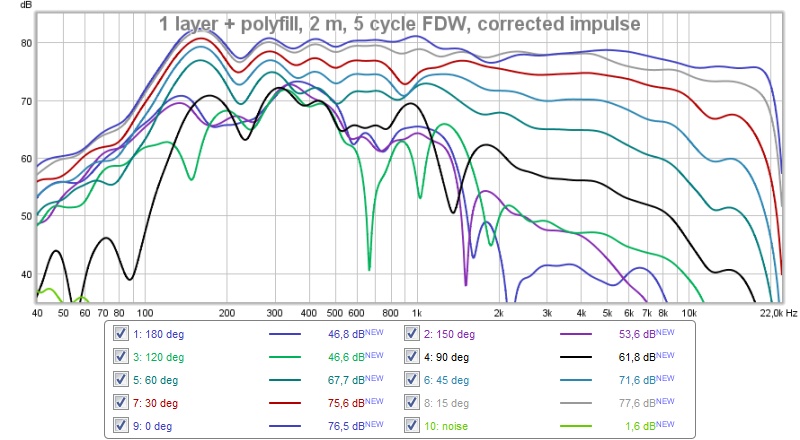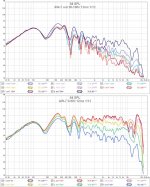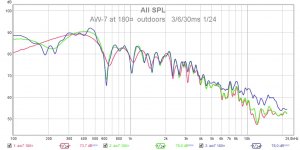They are 10db gradations, not 5db
The rear firing subs are to take advantage of boundary reinforcement using the front wall
Hi Frangus,
Yes, i'm aware of gradation. If you look at pic no.3 rear subs are 90dB at 100Hz, 500Hz-1200Hz is about -14dB. At pic no.1 tweeter 2kHz-10kHz is at 87dB but the subs hash varies from -18dB to -25dB in regard to tweeter response, more or less. Regarding boundary reinforcement, they've set the loudspeaker to free standing mode. When close to front wall user can activate Boundary mode and input distance from wall to the loudspeaker for right amount of boundary reinforcement to be used, in other words to reduce the driver output at low frequencies.
10 dB itself is quite a lot, why is 15dB to be bothered? Is it audible wrt 0dB midrange reference?
It does bother me, more at low frequencies than at highs, but yes. Depending if it is in phase or out of phase it can have quite an influence on sound. -14dB if out of phase with next driver in line can subtract up to few dB, or add if in phase. Other than that, if i'm to look at harmonic distortion that is -40dB (1%) as too much for high quality driver, then i will look at what happens that close to combined frequency response.
I'm not sure, but I think that the curves measured from the rear include tweeter and mid. That would explain the behavior at least.
/Anton
Since they are measured in an anechoic chamber at National Research Council of Canada, i'd be surprised if the sound radiated from midrange and tweeter wasn't absorbed by the chamber itself. Especially for tweeter. If you have anechoic chamber that can absorb tones only to -20dB , how can you measure distortion less than that. Mind you that -20dB would be 10% distortion. With that in mind, i'm quite positive that it is response emitted by those subs. Directivity at 2kHz and at 10kHz if high enough that nothing should be captured when measuring from behind in an anechoic room - but there it is.
Last edited:
I'm not saying the reflections from mid/tweeter. Actual output from mid/tweeter curving around the speaker.Since they are measured in an anechoic chamber at National Research Council of Canada, i'd be surprised if the sound radiated from midrange and tweeter wasn't absorbed by the chamber itself. Especially for tweeter. If you have anechoic chamber that can absorb tones only to -20dB , how can you measure distortion less than that. Mind you that -20dB would be 10% distortion.
The speaker is highly directional, but that does not mean 0 output rearward.
Here is a measurement of one of my cardioid speakers:

Tweeter from ~1 kHz. Note that the output at 120°-180° is 10-20 dB down for the midwoofers.
/Anton
You haven't measured it in an anechoic chamber. Those look to me like smoothed in-room measurements. You are picking up reflected sound, something not so common for reflection free environment such as anechoic chamber 
My guess is that, if measurements in NRCC are done with white or pink noise, something must have been rattling and produced hash at higher frequencies. That's no big deal. But 500-1200 i'd really like to see only midrange response, subs should be dead. That low it could be midrange leakage through side openings but we are not yet sure if they've measured only woofers or the whole speaker from behind. That's why i asked the question here because i expect Keyser will know the answer for sure. So, we'll have to wait for Keyser to read this and respond or soon i'll write to SoundStage because i'm really intrigued.
My guess is that, if measurements in NRCC are done with white or pink noise, something must have been rattling and produced hash at higher frequencies. That's no big deal. But 500-1200 i'd really like to see only midrange response, subs should be dead. That low it could be midrange leakage through side openings but we are not yet sure if they've measured only woofers or the whole speaker from behind. That's why i asked the question here because i expect Keyser will know the answer for sure. So, we'll have to wait for Keyser to read this and respond or soon i'll write to SoundStage because i'm really intrigued.
Last edited:
Nope, measured outdoorsYou haven't measured it in an anechoic chamber. Those are smoothed in-room measurements. You are picking up reflected sound, something not so common for reflection free environment such as anechoic chamber
My guess is that, if measurements in NRCC are done with white or pink noise, something must have been rattling and produced hash at higher frequencies. That isn't bad. But 500-1200 i'd really like to see only midrange response.
Do you really think that output is 0 dB rearward for any speaker?
Let's borrow this figure from kimmosaunisto:
An externally hosted image should be here but it was not working when we last tested it.
A (theoretical perfect) cardioid speaker has a null at 180°. A real speaker radiates only close to perfect. A tweeter in a waveguide does not have a null at 180°.
Edit: thought the figure was not gated, it is.
/Anton
Last edited:
I couldn't agree more. I don't expect a perfect null but i would expect less then what was measured. -20dB at 10kHz seems like a stretch to me. And about that directivity graph, it is not the same for all frequencies - that's for low frequencies.
As for your graphs few questions.
1. What is the distance from floor (mic and loudspeaker) ?
2. How long is gate time ?
My outdoor measurements at 2.5m height allows me to get about 10ms of gate time at 1m mic distance. When it's cold, i play in soon to be demolished volleyball court
As for your graphs few questions.
1. What is the distance from floor (mic and loudspeaker) ?
2. How long is gate time ?
My outdoor measurements at 2.5m height allows me to get about 10ms of gate time at 1m mic distance. When it's cold, i play in soon to be demolished volleyball court
Last edited:
As we are at Kimmo's website, here is Seas 27TBFC/G in Monacor waveguide at 0-90 degrees. Something similar D&D uses in their waveguide i'd say
I'll take 10kHz at -20dB at 90 degrees, but at 180 degrees ? Kinda strange to me. But maybe it's just me.
An externally hosted image should be here but it was not working when we last tested it.
I'll take 10kHz at -20dB at 90 degrees, but at 180 degrees ? Kinda strange to me. But maybe it's just me.
I am a bit puzzled of those NRC measurements too.
The frontside midrange has openings on the side, so it performs something like a cardioid, but it isn't symmetrical nor perfect for sure. Then the woofers radiating backwards, with some delay (measurement was with open space setting - optimized to frontside) interfering with frontside waves that "leak" backwards. So no wonder we see irregularities!
However, I am not worried about those backside wobbles, most likely they change with height and total radiated power is in reasonable harmony. I bet that KiiAudio Three woud have irregularities something like this too.
Here is list of speakers measured for Soundstage by NRC
We must remember also, that NRC chamber is not reliable below 80Hz.
This is my outdoor measurement of a 2-way with SEAS 6½" coaxial, up to 180¤. There is "leakage" also with very short gating.
The frontside midrange has openings on the side, so it performs something like a cardioid, but it isn't symmetrical nor perfect for sure. Then the woofers radiating backwards, with some delay (measurement was with open space setting - optimized to frontside) interfering with frontside waves that "leak" backwards. So no wonder we see irregularities!
However, I am not worried about those backside wobbles, most likely they change with height and total radiated power is in reasonable harmony. I bet that KiiAudio Three woud have irregularities something like this too.
Here is list of speakers measured for Soundstage by NRC
We must remember also, that NRC chamber is not reliable below 80Hz.
This is my outdoor measurement of a 2-way with SEAS 6½" coaxial, up to 180¤. There is "leakage" also with very short gating.
Attachments
Last edited:
Oh, yeah I agree. That is a little higher level than what I would expect. I misunderstood what you were trying to say.I couldn't agree more. I don't expect a perfect null but i would expect less then what was measured. -20dB at 10kHz seems like a stretch to me. And about that directivity graph, it is not the same for all frequencies - that's for low frequencies.
As for your graphs few questions.
1. What is the distance from floor (mic and loudspeaker) ?
2. How long is gate time ?
My outdoor measurements at 2.5m height allows me to get about 10ms of gate time at 1m mic distance. When it's cold, i play in soon to be demolished volleyball court
I was measuring about 1.5 m above ground and the gate is a 5 cycle frequency dependent window (FDW).
Maybe the 8C is more of a supercardiod? Doesn't explain high level around 10 kHz though. I have seen waveguide measurements with a higher level at 180 degrees than at 150 degrees due to constructive interference from right and left wave meeting behind the speaker. It would have been nice to see a full 0-180 plot.
/Anton
I'm happy to see you guys are interested in these measurements! I've read your questions and I think most of them are answered in the quite elaborate post I did on audiosciencereview: SoundStage’s review of Dutch&Dutch’s 8C | Page 7 | Audio Science Review (ASR) Forum
With respect to the measurements at 180 degrees, my own measurements look similar up to about 4k. Above that frequency in the NRC's measurements the response seems to move up in level a bit again. In my measurements in the anechoic chamber the downward trend continues but becomes a bit less steep. At 10k the level is about 35 dB lower than on-axis.
With respect to the measurements at 180 degrees, my own measurements look similar up to about 4k. Above that frequency in the NRC's measurements the response seems to move up in level a bit again. In my measurements in the anechoic chamber the downward trend continues but becomes a bit less steep. At 10k the level is about 35 dB lower than on-axis.
Hello guys,
I need some help, please.
For a pair of speakers like D&D 8c, I want to use this drivers:
- Tweeter: Seas H1499_27TBCD_GB-DXT (crossover @ 2KHz)
- Mid-Woofer: Seas h1252_l22rnx_p
- 2 subwoofers Wavecor SW223BD03
Do you think i can crossover at 100Hz?
I can replace the mid-woofer with SB23NBACS45-4 or SATORI MW19P-4 ?
Thanks in advance.
I need some help, please.
For a pair of speakers like D&D 8c, I want to use this drivers:
- Tweeter: Seas H1499_27TBCD_GB-DXT (crossover @ 2KHz)
- Mid-Woofer: Seas h1252_l22rnx_p
- 2 subwoofers Wavecor SW223BD03
Do you think i can crossover at 100Hz?
I can replace the mid-woofer with SB23NBACS45-4 or SATORI MW19P-4 ?
Thanks in advance.
That tweeter waveguide is too small to match its dispersion with the midrange driver. A better match is to either swap the woofer for a 6" driver or to take a larger waveguide.
6" mid / DXT waveguide, 1800 Hz crossover DIY Lautsprecher | DXT-MON | Nahfeldmonitor
8" mid / WG-300 waveguide, 1800 Hz crossover (which is too high for a smooth horizontal off-axis response) Monacor Momo
6" mid / DXT waveguide, 1800 Hz crossover DIY Lautsprecher | DXT-MON | Nahfeldmonitor
8" mid / WG-300 waveguide, 1800 Hz crossover (which is too high for a smooth horizontal off-axis response) Monacor Momo
Last edited:
Hello guys,
I need some help, please.
For a pair of speakers like D&D 8c, I want to use this drivers:
- Tweeter: Seas H1499_27TBCD_GB-DXT (crossover @ 2KHz)
- Mid-Woofer: Seas h1252_l22rnx_p
- 2 subwoofers Wavecor SW223BD03
Do you think i can crossover at 100Hz?
I can replace the mid-woofer with SB23NBACS45-4 or SATORI MW19P-4 ?
Thanks in advance.
Those drivers are very close to the ones we're using in the 8c (OEM versions from the same manufacturers). In order to get constant directivity and an 'invisible' crossover, you'll have to cross lower (1250 hz in the 8c). In order to do that, you'll need a bigger waveguide. The biggest challenge will be getting the acoustic cardioid enclosure right.
why is it so important to make crossover at 1200Hz?
Amphion Krypton 3 make crossover at 1600 Hz.
Grimm Audio LS1V2 make crossover at 1550 Hz. (without 8"waveguide) DXT technology it is so good ?
And I still have a curiosity.
How obvious is the difference between a cardio speaker (>100Hz) and a speaker with closed box in an acoustically treated room? If speakers use similar drivers...
Amphion Krypton 3 make crossover at 1600 Hz.
Grimm Audio LS1V2 make crossover at 1550 Hz. (without 8"waveguide) DXT technology it is so good ?
And I still have a curiosity.
How obvious is the difference between a cardio speaker (>100Hz) and a speaker with closed box in an acoustically treated room? If speakers use similar drivers...
why is it so important to make crossover at 1200Hz?
Amphion Krypton 3 make crossover at 1600 Hz.
Grimm Audio LS1V2 make crossover at 1550 Hz. (without 8"waveguide) DXT technology it is so good ?
Consider that you’re trying not only to match directivity at the crossover between midwoofer and tweeter, but also match both of the above to the cardioid midbass. That limits your crossover flexibility. Closed box speakers all expand to omni at LF, so there you only care about the tweeter to midwoofer match.
- Status
- This old topic is closed. If you want to reopen this topic, contact a moderator using the "Report Post" button.
- Home
- Loudspeakers
- Multi-Way
- 2-way: Waveguide + Cardioid-like

